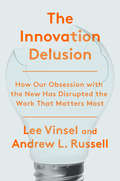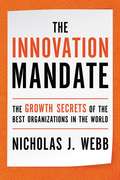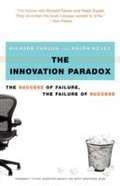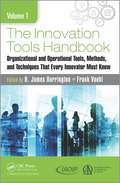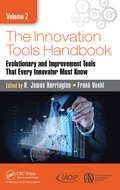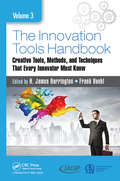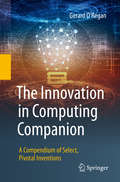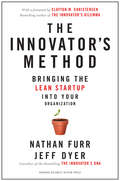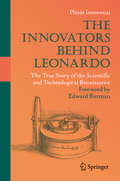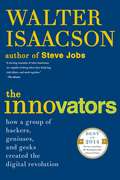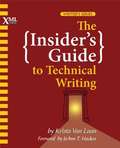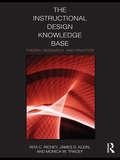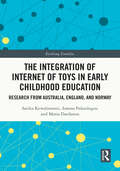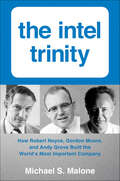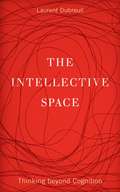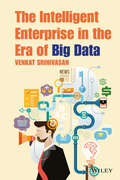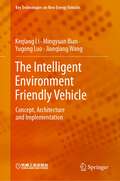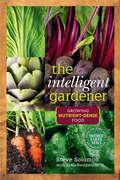- Table View
- List View
The Innovation Delusion: How Our Obsession with the New Has Disrupted the Work That Matters Most
by Andrew L. Russell Lee VinselInnovation is the hottest buzzword in business. But what if our obsession with finding the next big thing has distracted us from the work that matters most?&“The most important book I&’ve read in a long time . . . It explains so much about what is wrong with our technology, our economy, and the world, and gives a simple recipe for how to fix it: Focus on understanding what it takes for your products and services to last.&”—Tim O&’Reilly, founder of O&’Reilly Media It&’s hard to avoid innovation these days. Nearly every product gets marketed as being disruptive, whether it&’s genuinely a new invention or just a new toothbrush. But in this manifesto on thestate of American work, historians of technology Lee Vinsel and Andrew L. Russell argue that our way of thinking about and pursuing innovation has made us poorer, less safe, and—ironically—less innovative. Drawing on years of original research and reporting, The Innovation Delusion shows how the ideology of change for its own sake has proved a disaster. Corporations have spent millions hiring chief innovation officers while their core businesses tank. Computer science programs have drilled their students on programming and design, even though theoverwhelming majority of jobs are in IT and maintenance. In countless cities, suburban sprawl has left local governments with loads of deferred repairs that they can&’t afford to fix. And sometimes innovation even kills—like in 2018 when a Miami bridge hailed for its innovative design collapsed onto a highway and killed six people. In this provocative, deeply researched book, Vinsel and Russell tell the story of how we devalued the work that underpins modern life—and, in doing so, wrecked our economy and public infrastructure while lining the pockets of consultants who combine the ego of Silicon Valley with the worst of Wall Street&’s greed. The authors offer a compelling plan for how we can shift our focus away from the pursuit of growth at all costs, and back toward neglected activities like maintenance, care, and upkeep. For anyone concerned by the crumbling state of our roads and bridges or the direction our economy is headed, The Innovation Delusion is a deeply necessary reevaluation of a trend we can still disrupt.
The Innovation Mandate: The Growth Secrets of the Best Organizations in the World
by Nicholas WebbIn clear language, The Innovation Mandate shows leaders a step-by-step process to continually generate great ideas, implement them, and maximize their value to benefit both customers and investors.In today’s ultracompetitive marketplace, the difference between success and failure is innovation. From small entrepreneurial startups to global Fortune 500 companies, innovation--the steady flow of new ideas--drives sustained success. It allows a company to introduce new products and services, effectively connect with customers, sharpen the supply chain, efficiently manage finances, and hire and retain the best people. Without a steady stream of new ideas, even the best company will slow down, atrophy, lose market share, hemorrhage customers, and eventually close or be sold. The Innovation Mandate offers a clear and straightforward pathway to profitable innovation. It demystifies the concept, making it easy to understand, implement, and measure. The book centers around three simple concepts: innovation generates profits; innovation, in the form of new, profitable ideas, can come from anywhere; and identifying, harnessing, evaluating, and implementing these new ideas cannot be left to chance. Additionally, the book offers a five-point checklist to ensure your company is innovation ready.
The Innovation Paradox: The Success of Failure, the Failure of Success
by Richard Farson Ralph KeyesAuthors argue that failure has its upside, success its downside. Both are steps toward achievement, and the two extremes are not as distinct as we imagine. In today's business economy, it's not success or failure -- it's success and failure that lead to genuine innovation.
The Innovation Revolution in Agriculture: A Roadmap to Value Creation
by Hugo CamposThis open access book is an important reframing of the role of innovation in agriculture. Dr. Campos and his distinguished coauthors address the need for agriculture to feed a growing global population with a reduced environmental footprint while adapting to and mitigating the effects of changing climate. The authors expand the customary discussion of innovation in terms of supply driven R&D to focus on the returns to investors and most importantly, the value to end-users. This is brought to life by exploring effective business models and many cases from agricultural systems across the globe. The focus on converting the results of innovation in R&D into adoption by farmers and other end-users is its greatest contribution. Many lessons from the book can be applied to private and public sectors across an array of agricultural systems. This book will be of enormous value to agri-business professionals, NGO leaders, agricultural and development researchers and those funding innovation and agriculture across the private and public sectors. Tony Cavalieri, Senior Program Officer, Bill & Melinda Gates Foundation Hugo Campos, Ph.D., MBA, has 20+ years of international corporate and development experience. His distinguished coauthors represent a rich collection of successful innovation practice in industry, consultancy, international development and academy, in both developed and developing countries.”
The Innovation Tools Handbook, Volume 1: Organizational and Operational Tools, Methods, and Techniques that Every Innovator Must Know
by H. James Harrington Frank VoehlIn today‘s fast-moving, high-technology environment, the focus on quality has given way to a focus on innovation. From presidents of the United States to presidents of Fortune 500 companies, it is clear that everyone thinks innovation is extremely important. The challenge is that few people stop to define why innovation is important to understand w
The Innovation Tools Handbook, Volume 2: Evolutionary and Improvement Tools that Every Innovator Must Know
by H. James Harrington Frank VoehlIn today’s fast-moving, high-technology environment, the focus on quality has given way to a focus on innovation. From presidents of the United States to presidents of Fortune 500 companies, it is clear that everyone thinks innovation is extremely important. The challenge is that few people stop to define why innovation is important—to understand what’s driving the need for more innovation. We all agree that more frequent innovation is important, even necessary.There is actually a growing body of evidence that indicates that looking outside of your company (rather than purely looking internally) and to customers’ needs, using the tools in this Handbook, will lead to more innovative ideas. Responding to customers’ needs is the key to a successful business. You can use these tools to talk to customers—satisfied ones, unsatisfied ones, potential customers, people who would never buy your product or service, and also people you have never considered as a potential customer. In addition, these tools will help you ask your competitors’ customers about what makes them happy with the current businesses and offerings in the industry, why they buy or do not buy from you, your competitors, and other industries. These tools will help you understand the steps in the customer journey they need to take, what delights and frustrates them, and what their pain points are.The three volumes of The Innovation Tools Handbook cover 76 top-rated tools and methods, from the hundreds available, that every innovator must master to be successful. Covering evolutionary and/or improvement innovative tools and methodologies, Volume 2 presents 23 tools/methodologies related to innovative evolutionary products, processes, and services, or the improvement of existing ones.For each tool, the book provides a definition, identifies the user of the tool, explains what phases of the innovation process the tool is used, describes how the tool is used, supplies examples of the outputs from the tool, identifies software that can maximize its effectiveness, and includes references and suggestions for further reading. Ideation is about developing ideas on how to seize identified opportunities. What are the possible answers to your breakthrough questions? Having a deep understanding about the customer, their needs and pain points, as well as the existing solutions (i.e. business models in the industry) will naturally lead to new ideas. How seriously you do your discovery homework using the tools in these Handbooks will determine not only how fast you create ideas, but about how likely these ideas are to succeed.Tools and methodologies covered include: 5 why questions, Affinity diagrams, attribute listing, brainwriting 6–3–5, cause-and-effect diagrams, creative problem solving model, design for tools, flowcharting, force field analysis, Kano analysis, nominal group technique, plan–do–check–act, reengineering/redesign, reverse engineering, robust design, SCAMPER, simulations, six thinking hats, social networks, solution analysis diagrams, statistical analysis, tree diagram, and value analysis.The authors believe that by making effective use of the tools and methodologies presented in this book, your organization can increase the percentage of creative/innovative ideas by five to eight times its present performance level.
The Innovation Tools Handbook, Volume 3: Creative Tools, Methods, and Techniques that Every Innovator Must Know
by H. James Harrington and Frank VoehlThis book focuses on the creative tools and techniques, decisions, activities, and practices that move ideas to realization generate business value. It has a unique leaning on learning and mastering the improvement tools for managing the investment in creating new opportunities for generating customer value. It includes the discipline of managing the creative tools, methods and processes involved in innovation. It can be used to develop both product and organizational innovation. This Handbook includes a set of tools that allow managers and engineers to cooperate with a common understanding of goals and processes.
The Innovation for Development Report 2010—2011
by Augusto López-ClarosThis report provides a comprehensive look at the role of innovation in promoting economic and social development. It examines the impact of innovation on the economic growth of developing countries and the future role of technological innovation in international efforts to mitigate the effects of climate change, amongst many other issues.
The Innovation in Computing Companion: A Compendium of Select, Pivotal Inventions
by Gerard O’ReganThis encyclopedic reference provides a concise and engaging overview of the groundbreaking inventions and conceptual innovations that have shaped the field of computing, and the technology that runs the modern world. Each alphabetically-ordered entry presents a brief account of a pivotal innovation and the great minds behind it, selected from a wide range of diverse topics.Topics and features:Describes the development of Babbage’s computing machines, Leibniz’s binary arithmetic, Boole’s symbolic logic, and Von Neumann architectureReviews a range of historical analog and digital computers, significant mainframes and minicomputers, and pioneering home and personal computersDiscusses a selection of programming languages and operating systems, along with key concepts in software engineering and commercial computingExamines the invention of the transistor, the integrated circuit, and the microprocessorRelates the history of such developments in personal computing as the mouse, the GUI, Atari video games, and Microsoft OfficeSurveys innovations in communications, covering mobile phones, WiFi, the Internet and World Wide Web, e-commerce, smartphones, social media, and GPSPresents coverage of topics on artificial intelligence, the ATM, digital photography and digital music, robotics, and WikipediaContains self-test quizzes and a helpful glossaryThis enjoyable compendium will appeal to the general reader curious about the intellectual milestones that led to the digital age, as well as to the student of computer science seeking a primer on the history of their field.Dr. Gerard O'Regan is a CMMI software process improvement consultant with research interests including software quality and software process improvement, mathematical approaches to software quality, and the history of computing. He is the author of such Springer titles as World of Computing, Concise Guide to Formal Methods, Concise Guide to Software Engineering, and Guide to Discrete Mathematics.
The Innovator's Method: Bringing the Lean Start-up into Your Organization
by Jeff Dyer Nathan FurrHave you ever come up with an idea for a new product or service but didn’t take any action because you thought it would be too risky? Or at work, have you had what you thought could be a big idea for your company-perhaps changing the way you develop or distribute a product, provide customer service, or hire and train your employees? If you have, but you haven’t known how to take the next step, you need to understand what the authors call the innovator’s method-a set of tools emerging from lean start-up, design thinking, and agile software development that are revolutionizing how new ideas are created, refined, and brought to market. To date these tools have helped entrepreneurs, designers, and software developers manage uncertainty-through cheap and rapid experiments that systematically lower failure rates and risk. But many managers and leaders struggle to apply these powerful tools within their organizations, as they often run counter to traditional managerial thinking and practice. Authors Nathan Furr and Jeff Dyer wrote this book to address that very problem. Following the breakout success of The Innovator’s DNA-which Dyer wrote with Hal Gregersen and bestselling author Clay Christensen to provide a framework for generating ideas-this book shows how to make those ideas actually happen, to commercialize them for success. Based on their research inside corporations and successful start-ups, Furr and Dyer developed the innovator’s method, an end-to-end process for creating, refining, and bringing ideas to market. They show when and how to apply the tools of their method, how to adapt them to your business, and how to answer commonly asked questions about the method itself, including: How do we know if this idea is worth pursuing? Have we found the right solution? What is the best business model for this new offering? This book focuses on the "how”-how to test, how to validate, and how to commercialize ideas with the lean, design, and agile techniques successful start-ups use. Whether you’re launching a start-up, leading an established one, or simply working to get a new product off the ground in an existing company, this book is for you.
The Innovators Behind Leonardo: The True Story of the Scientific and Technological Renaissance
by Plinio InnocenziThis engaging book places Leonardo da Vinci’s scientific achievements within the wider context of the rapid development that occurred during the Renaissance. It demonstrates how his contributions were not in fact born of isolated genius, but rather part of a rich period of collective advancement in science and technology, which began at least 50 years prior to his birth.Readers will discover a very special moment in history, when creativity and imagination were changing the future—shaping our present. They will be amazed to discover how many technological inventions had already been conceived or even designed by the engineers and inventors who preceded Leonardo, such as Francesco di Giorgio and Taccola, the so-called Siena engineers. This engaging volume features a wealth of illustrations from a variety of original sources, such as manuscripts and codices, enabling the reader to see and judge for him or herself the influence that other Renaissance engineers and inventors had on Leonardo.
The Innovators: How a Group of Hackers, Geniuses, and Geeks Created the Digital Revolution
by Walter IsaacsonFollowing his blockbuster biography of Steve Jobs, Walter Isaacson&’s New York Times bestselling and critically acclaimed The Innovators is a &“riveting, propulsive, and at times deeply moving&” (The Atlantic) story of the people who created the computer and the internet.What were the talents that allowed certain inventors and entrepreneurs to turn their visionary ideas into disruptive realities? What led to their creative leaps? Why did some succeed and others fail? The Innovators is a masterly saga of collaborative genius destined to be the standard history of the digital revolution—and an indispensable guide to how innovation really happens. Isaacson begins the adventure with Ada Lovelace, Lord Byron’s daughter, who pioneered computer programming in the 1840s. He explores the fascinating personalities that created our current digital revolution, such as Vannevar Bush, Alan Turing, John von Neumann, J.C.R. Licklider, Doug Engelbart, Robert Noyce, Bill Gates, Steve Wozniak, Steve Jobs, Tim Berners-Lee, and Larry Page. This is the story of how their minds worked and what made them so inventive. It’s also a narrative of how their ability to collaborate and master the art of teamwork made them even more creative. For an era that seeks to foster innovation, creativity, and teamwork, The Innovators is “a sweeping and surprisingly tenderhearted history of the digital age” (The New York Times).
The Insect & Spider Collections of the World (CRC Press Revivals)
by Ross H. Arnett, Jr. G. Allan Samuelson Gordon M. NishidaFirst published in 1993, completely rewritten, this second edition includes a list of all 210 countries of the world and all of the islands, with comments on the existence of insect and spider collections, both public and private. These listings are arranged alphabetically by country, state/province, and city, with private collections listed under the public collection with which they are registered. Part II of the directory is an alphabetical list of the codes assigned to each of the collections described in Part I. This list is also cross-referenced to variations of the codes used in other works, which will eliminate any confusion over this duplication. This classic work provides a ready reference to all collections and is required by all insect and spider systematists.
The Insider's Guide to Technical Writing
by Krista Van LaanEvery complex product needs to be explained to its users, and technical writers, also known as technical communicators, are the ones who do that job. A growing field, technical writing requires multiple skills, including an understanding of technology, writing ability, and great people skills. Whether you're thinking of becoming a technical writer, just starting out, or you've been working for a while and feel the need to take your skills to the next level, The Insider's Guide to Technical Writing can help you be a successful technical writer and build a satisfying career. Inside the Book Is This Job for Me? What does it take to be a technical writer? Building the Foundation: What skills and tools do you need to get started? The Best Laid Plans: How do you create a schedule that won't make you go crazy? How do you manage different development processes, including Agile methodologies? On the Job: What does it take to walk into a job and be productive right away? The Tech Writer Toolkit: How do you create style guides, indexes, templates and layouts? How do you manage localization and translation and all the other non-writing parts of the job? I Love My Job: How do you handle the ups and downs of being a technical writer? Appendixes: References to websites, books, and other resources to keep you learning. Index
The Institutional Development of Podcasting: From Participatory Practice to Platform Content (Disruptions)
by Aske Kammer Thomas Spejlborg SejersenReferring back to the early 2000s, this book traces the development of podcasting from a “do-it-yourself” medium by amateurs into its current environment, where a wide variety of individuals, organizations, and platforms operate in an increasingly crowded and competitive market.Through original case studies of shows and platforms including "The Daily" and Spotify, the authors explore the processes and effects of commercialization, platformization, and datafication in the industry. Drawing on institutional theory and the growing body of scholarly literature about podcasting, they examine the shifts and reorientations in institutional logics that characterize podcasting and present the different types of actors that operate in the commercial and noncommercial podcast markets.The Institutional Development of Podcasting will be of interest to advanced students and researchers of audio media, journalism, and media industries.
The Instructional Design Knowledge Base
by Rita C. Richey James D. Klein Monica W. TraceyThe Instructional Design Knowledge Base: Theory, Research and Practice provides ID professionals and students at all levels with a comprehensive exploration of the theories and research that serve as a foundation for current and emerging ID practice. This book offers both current and classic interpretations of theory from a range of disciplines and approaches. It encompasses general systems, communication, learning, early instructional, media, conditions-based, constructivist design and performance-improvement theories. Features include: rich representations of the ID literature concise theory summaries specific examples of how theory is applied to practice recommendations for future research a glossary of related terms a comprehensive list of references. A perfect resource for instructional design and technology doctoral, masters and educational specialist certificate programs, The Instructional Design Knowledge Base provides students and scholars with a comprehensive background for ID practice and a foundation for future ID thinking.
The Instructional Design Trainer’s Guide: Authentic Practices and Considerations for Mentoring ID and Ed Tech Professionals
by Jill E. Stefaniak Rebecca M. ReeseThe Instructional Design Trainer’s Guide provides foundational concepts and actionable strategies for training and mentoring instructional design and educational technology students to be effective across contexts. ID faculty are charged with bridging the gap between research and practice preparing graduate students for the real-world workforce. This book provides trainers and university programs with authentic learning experiences that better articulate the practices of and demands on design and technology professionals in the field. Through this enhanced perspective, learners will be better positioned to confidently embrace constraints, work among changing project expectations, interact with multiple stakeholders, and convey to employers the skills and competencies gleaned from their formal preparation.
The Instructional Design Trainer’s Guide: Authentic Practices and Considerations for Mentoring ID and Ed Tech Professionals
by Jill E. Stefaniak Rebecca M. ReeseThe Instructional Design Trainer’s Guide provides foundational concepts and actionable strategies for training and mentoring instructional design and educational technology students to be effective across contexts. ID faculty are charged with bridging the gap between research and practice preparing graduate students for the real-world workforce. This book provides trainers and university programs with authentic learning experiences that better articulate the practices of and demands on design and technology professionals in the field. Through this enhanced perspective, learners will be better positioned to confidently embrace constraints, work among changing project expectations, interact with multiple stakeholders, and convey to employers the skills and competencies gleaned from their formal preparation.
The Integration of Internet of Toys in Early Childhood Education: Research from Australia, England, and Norway (Evolving Families)
by Ioanna Palaiologou Sarika Kewalramani Maria DardanouThis book offers a fresh look at recent developments in policy, curricula and pedagogical discourse around children’s play with Internet of Toys (IoToys). By expanding the notion of digital and smart play perspectives in early childhood education, the authors critique and develop the broader subject area of IoToys play to better serve its end users. The book brings together research from across three different countries: Australia, Norway and England. It offers tangible examples of how one can use IoToys to build children’s social skills, emotional intelligence, sense of achievement, collaboration and aspects of STEM and design play thinking processes. The learning stories of children’s IoToys play will deliver a comprehensive review of how practitioners and parents can come together to build communities of practice for (re)enhancing children’s learning and growth using evolving technology-based play and engage in paradigmatic debates. Readers as a result will better appreciate the growth in pragmatic applications of technologies together with theoretical perspectives. The book will be a valuable resource for any academic or practitioner just beginning to understand the complexities and success stories of integrating IoToys for children’s playful learning.
The Intel Trinity: How Robert Noyce, Gordon Moore, and Andy Grove Built the World's Most Important Company
by Michael S. MaloneBased on unprecedented access to the corporation’s archives, The Intel Trinity is the first full history of Intel Corporation—the essential company of the digital age— told through the lives of the three most important figures in the company’s history: Robert Noyce, Gordon Moore, and Andy Grove.Often hailed the “most important company in the world,” Intel remains, more than four decades after its inception, a defining company of the global digital economy. The legendary inventors of the microprocessor-the single most important product in the modern world-Intel today builds the tiny “engines” that power almost every intelligent electronic device on the planet.But the true story of Intel is the human story of the trio of geniuses behind it. Michael S. Malone reveals how each brought different things to Intel, and at different times. Noyce, the most respected high tech figure of his generation, brought credibility (and money) to the company’s founding; Moore made Intel the world’s technological leader; and Grove, has relentlessly driven the company to ever-higher levels of success and competitiveness. Without any one of these figures, Intel would never have achieved its historic success; with them, Intel made possible the personal computer, Internet, telecommunications, and the personal electronics revolutions.The Intel Trinity is not just the story of Intel’s legendary past; it also offers an analysis of the formidable challenges that lie ahead as the company struggles to maintain its dominance, its culture, and its legacy.With eight pages of black-and-white photos.
The Intellective Space: Thinking beyond Cognition (Posthumanities #32)
by Laurent DubreuilThe Intellective Space explores the nature and limits of thought. It celebrates the poetic virtues of language and the creative imperfections of our animal minds while pleading for a renewal of the humanities that is grounded in a study of the sciences.According to Laurent Dubreuil, we humans both say more than we think and think more than we say. Dubreuil&’s particular interest is the intellective space, a space where thought and knowledge are performed and shared. For Dubreuil, the term &“cognition&” refers to the minimal level of our mental operations. But he suggests that for humans there is an excess of cognition due to our extensive processing necessary for verbal language, brain dynamics, and social contexts. In articulating the intellective, Dubreuil includes &“the productive undoing of cognition.&”Dubreuil grants that cognitive operations take place and that protocols of experimental psychology, new techniques of neuroimagery, and mathematical or computerized models provide access to a certain understanding of thought. But he argues that there is something in thinking that bypasses cognitive structures. Seeking to theorize with the sciences, the book&’s first section develops the &“intellective hypothesis&” and points toward the potential journey of ideas going beyond cognition, after and before computation. The second part, &“Animal Meditations,&” pursues some of the consequences of this hypothesis with regard to the disparaged but enduring project of metaphysics, with its emphasis on categories such as reality, humanness, and the soul.
The Intelligent Enterprise in the Era of Big Data
by Venkat SrinivasanAn innovative guide to the organization and function of enterprises in the technological age In the era of big data and automation, this book presents a cutting-edge approach in how enterprises should organize and function. Striking a practical balance between theory and practice, The Intelligent Enterprise in the Era of Big Data presents an enterprise architecture that embodies the power of the emerging technology environment. Beginning with an introduction to the key challenges that enterprises face, the book systematically outlines a modern enterprise architecture through a detailed discussion of the inseparable elements of such an architecture: efficiency, flexibility, and intelligence. This architecture enables rapid responses to market needs by facilitating intelligent, flexible automation of enterprise business processes and sensing important developments in internal and external environments in near real time. Illustrating all of these elements in an integrated fashion, The Intelligent Enterprise in the Era of Big Data also features: A detailed discussion on issues of time-to-market and flexibility with respect to enterprise application technology Novel analyses illustrated through extensive real-world case studies to help readers better understand the applicability of the architecture and concepts Practical approaches for designing and building intelligent enterprises An appendix that presents various approaches to text analysis with real-world business implications The Intelligent Enterprise in the Era of Big Data is an appropriate reference for business executives, information technology professionals, data scientists, and management consultants.
The Intelligent Environment Friendly Vehicle: Concept, Architecture and Implementation (Key Technologies on New Energy Vehicles)
by Keqiang Li Mingyuan Bian Yugong Luo Jianqiang WangThis book elaborates the fundamentals, new concepts and key technologies of the Intelligent Environment Friendly Vehicle (i-EFV), and the engineering implementation of these technologies such as structure sharing, data fusion and control coordination. With lots of illustrations, it summaries the authors’ research in the field of automotive intelligent technology and electric vehicle control for the past twenty years, enabling readers to grasp the essence of automotive power revolution, intelligent revolution and information revolution. Opening up new scientific horizons and fostering innovative thinking, the book is a valuable resource for researchers as well as undergraduate and graduate students.
The Intelligent Gardener: Growing Nutrient-Dense Food (Mother Earth News Books for Wiser Living)
by Steve Solomon Erica Reinheimer&“It is bold, it is courageous, and it challenges many of our preconceptions about food, about soils, about farming, and about health.&” —Michael Ableman, farmer, author of Farm the City To grow produce of the highest nutritional quality, the essential minerals lacking in our soil from intensive agriculture must be replaced. The Intelligent Gardener is the practical, step-by-step guide for any serious gardener who wants to: · Demystify this process · Debunk much of the false and misleading information perpetuated by both the conventional and organic agricultural movements · Re-mineralize our soil. Accompanied with customizable web-based spreadsheets, this toolkit calls for far more attention to detail than the simple addition of composted manure or NPK fertilizers. It conclusively establishes the link between healthy soil, healthy food, and healthy people. Vegetables, fruits, and grains are a major source of vital nutrients, but centuries of intensive agriculture have depleted our soils to historic lows. As a result, the broccoli you consume today may have less than half the vitamins and minerals that the equivalent serving would have contained a hundred years ago. This is a matter of serious concern, since poor nutrition has been linked to myriad health problems including cancer, heart disease, obesity, high blood pressure, and diabetes. For optimum health we must increase the nutrient density of our foods to the levels enjoyed by previous generations. The Intelligent Gardener goes beyond organic—it offers the essential tools for those who care about the quality of the produce they grow. &“It&’s hard to imagine this book not having a significant and lasting impact on the way organic farmers and gardeners grow their crops.&” —Mark McDonald, West Coast Seeds
The Intelligent Safety of Automobile (Key Technologies on New Energy Vehicles)
by Hong Wang Jianqiang Wang Bingbing NieThe book expounds the current research and development trend of intelligent safety technology of automobile, and analyzes and excavates the new safety technology to the automobile. It introduces the basic theory, core method, key technology, main system, test evaluation and innovation practice of intelligent safety of automobile for readers, providing a certain theoretical and practical basis for the safety development of the automobile.This book is elaborated from the perspective of the driver-vehicle-road system. The traffic accidents are divided into three stages for discussion: before, during and after the collision. This book constructs a new systematic structure for Safety theory and technical system of several key links, including system safety, operation safety, intelligent protection and safety evaluation. It will be a useful reference for researchers and practitioners in the field of automobile engineering and auto pilot.
